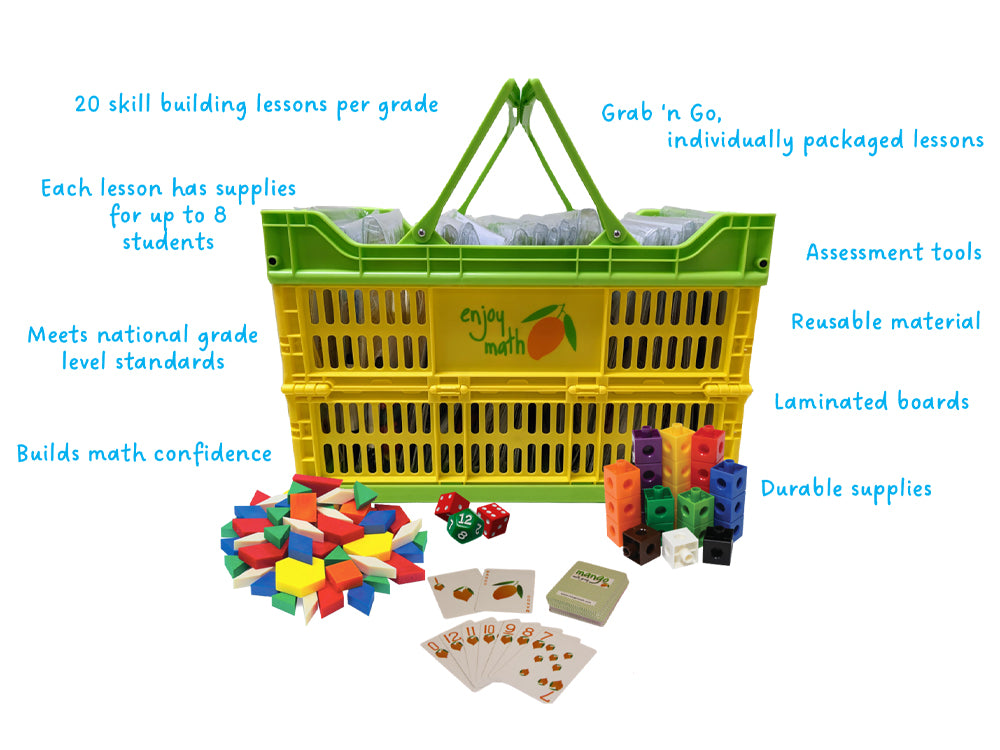
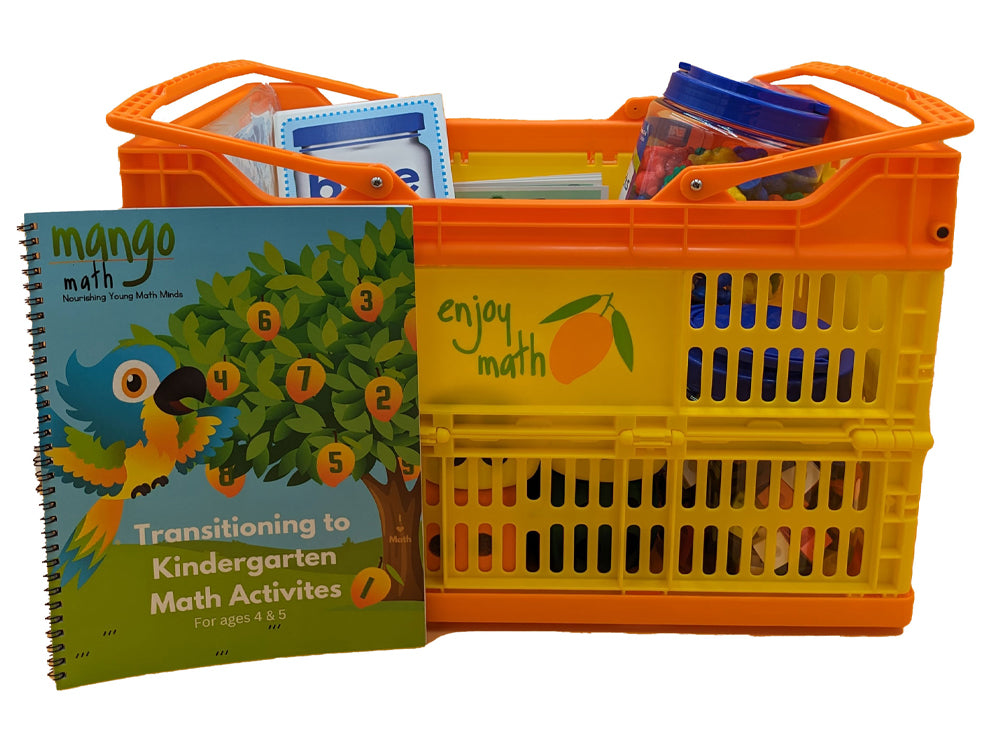
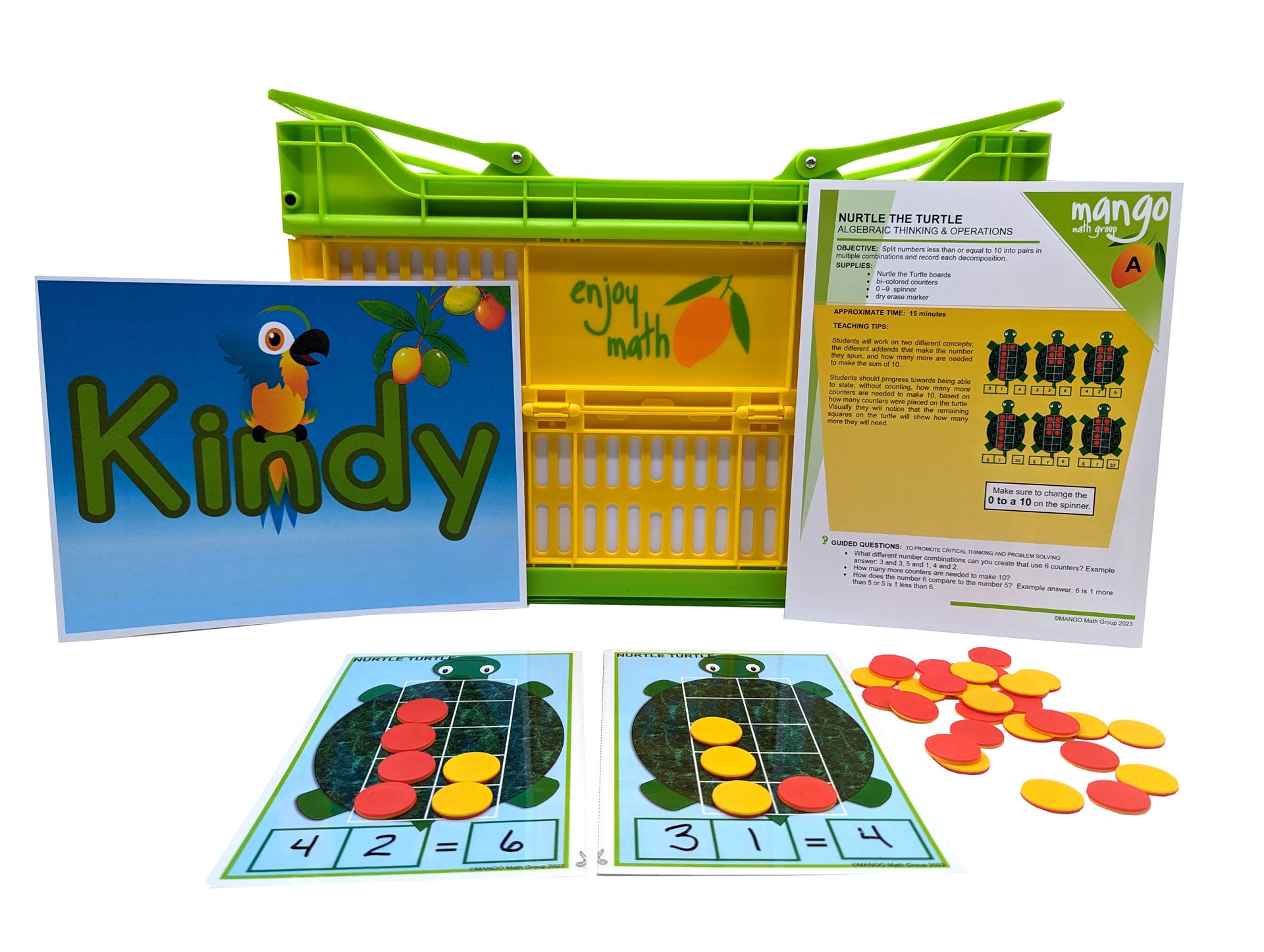

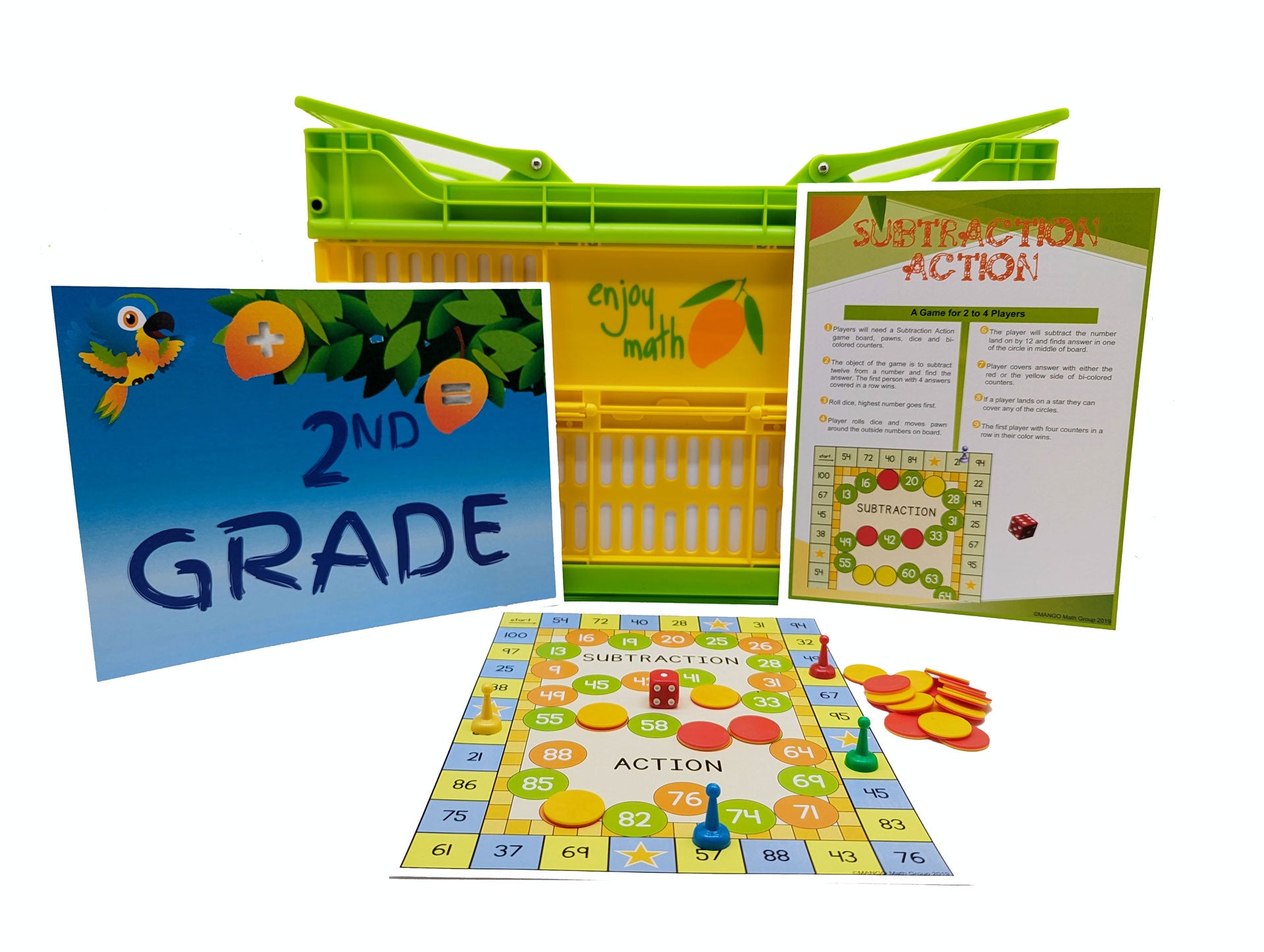
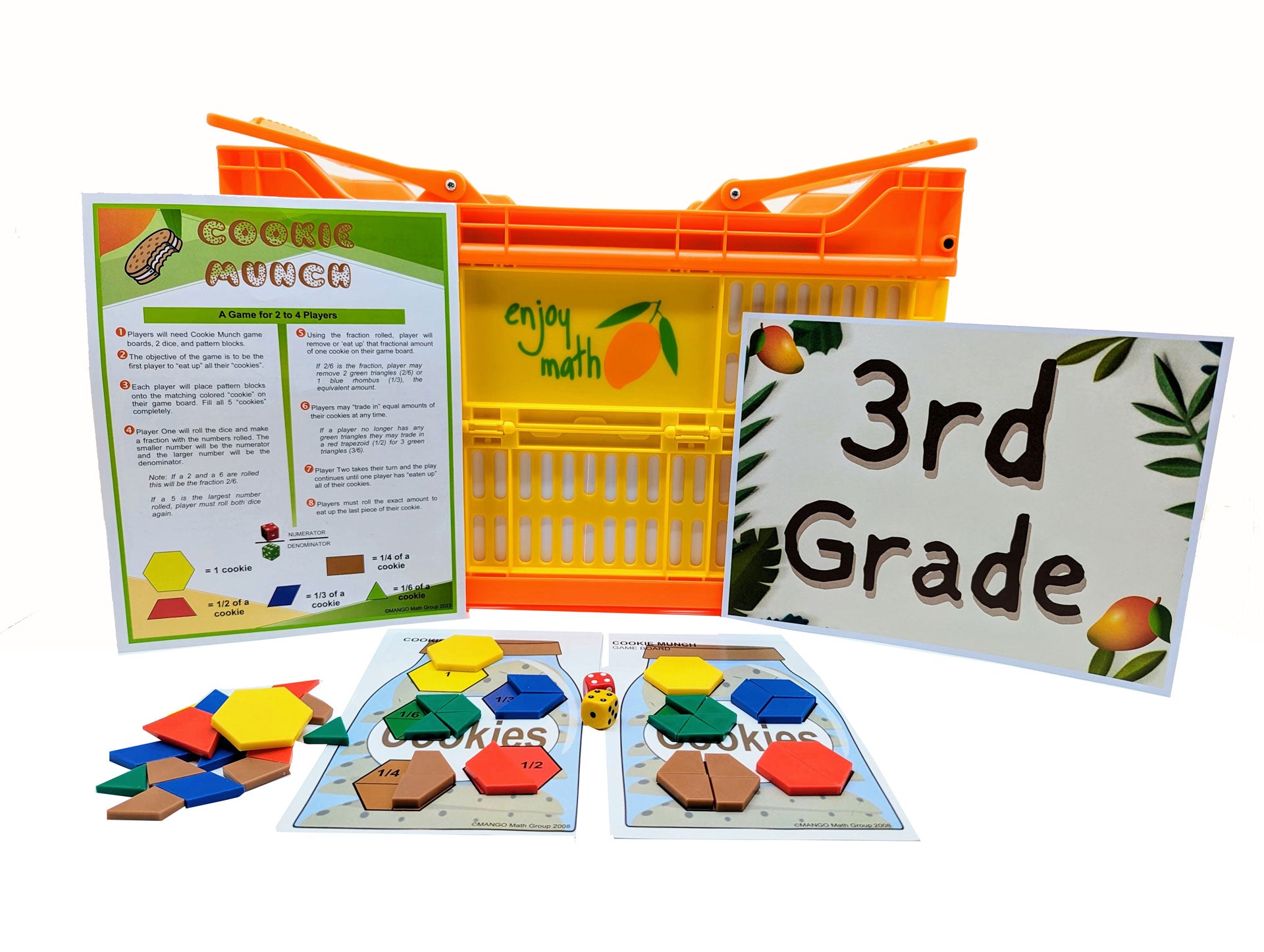


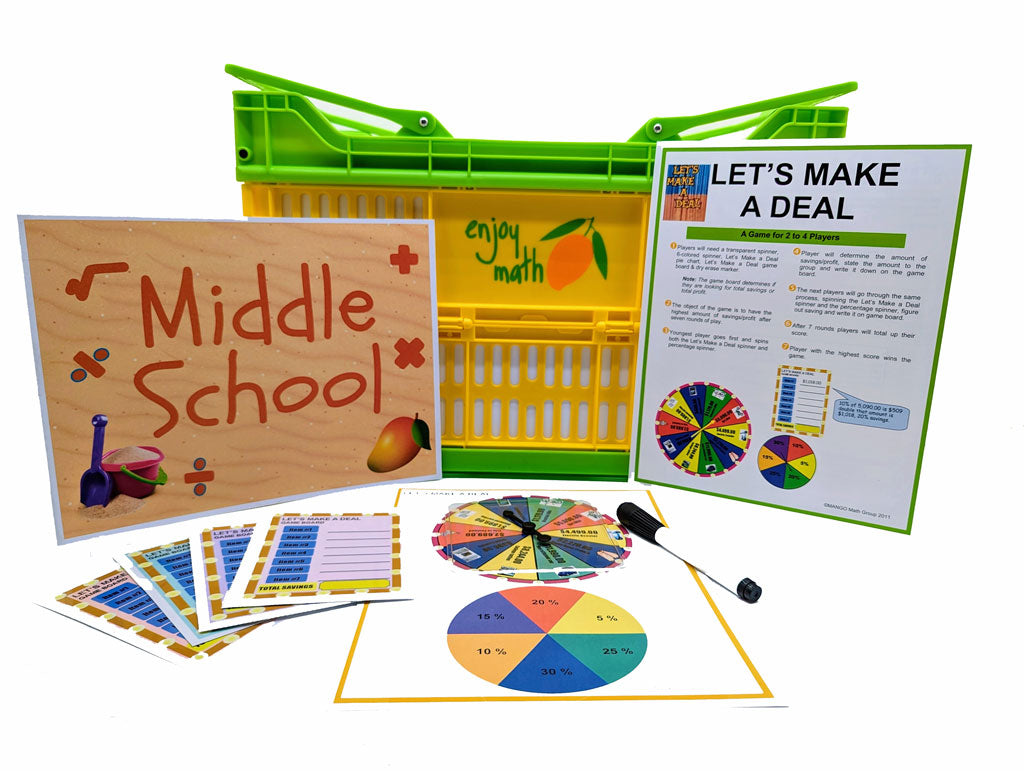
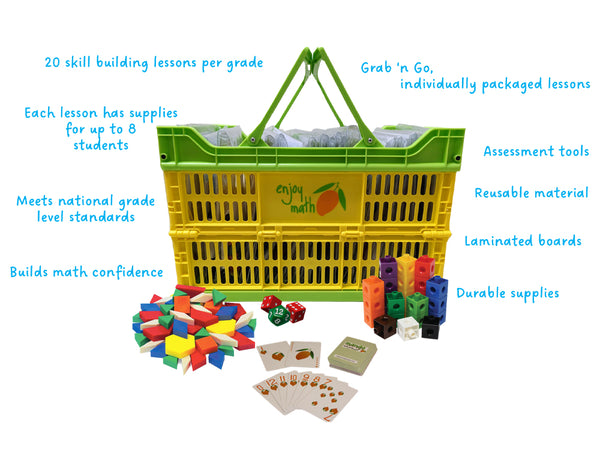

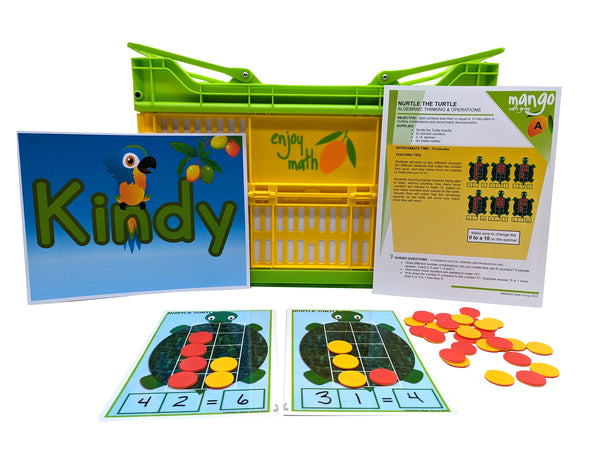

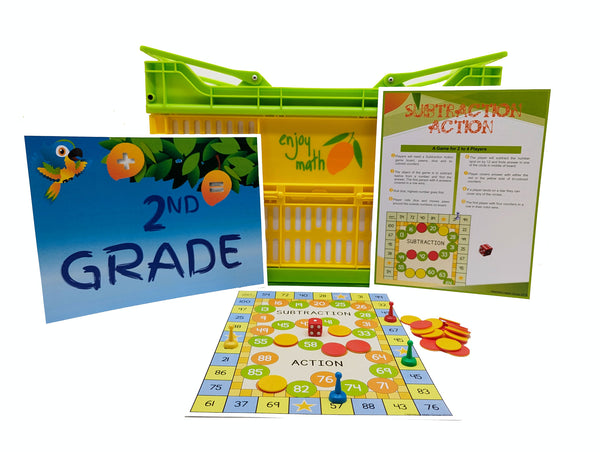

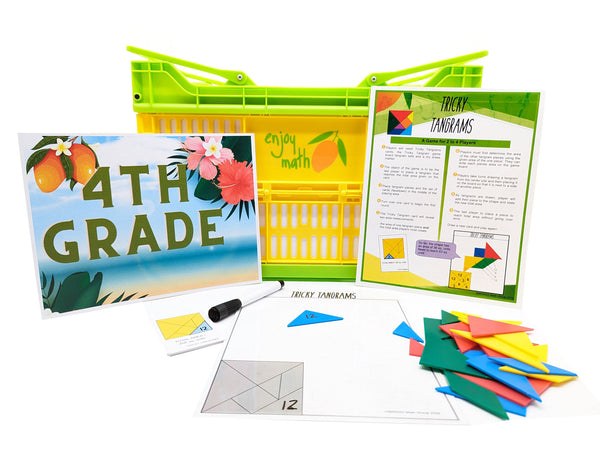
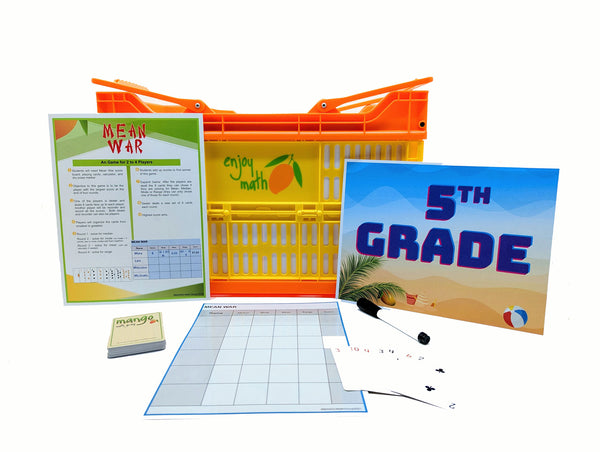
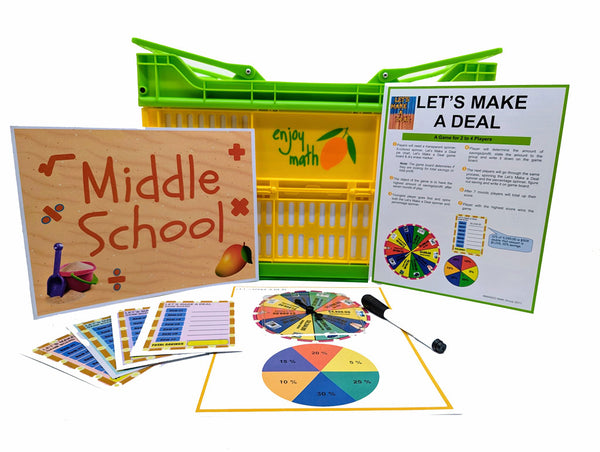
















MANGO Math Deluxe Kits
- Price
- 3,795 USD
Help kids practice math in ways they enjoy!
Math is the single strongest indicator for future academic and financial success and MANGO Math Kits help to create that strong foundation.
Each kit includes 20 skill-building, individually packaged lessons per grade. Perfect for setting up stations for students to rotate through, each lesson provides fun, confidence-boosting math games for up to eight students!
While having fun, students learn collaboration, communication, critical thinking and creativity – all necessary skills of the 21st Century.
Grades: TK, K, 1, 2, 3, 4, 5, 6-8
Students: Up to 8 per lesson
Reusability and Expansion:
- 100% Reusable: The materials in this program are 100% reusable. Just clean and reuse again and again.
Settings & Tech Requirements
Recommended Settings:
- Summer Camps
- Classrooms
- Out-of-School Time Programs
Tech Requirements:
- None
Curriculum Topics
Curriculum Topics:
- Make sense of problems and persevere in solving them
- Reason abstractly and quantitatively
- Construct viable arguments and critique the reasoning of others
- Model with mathematics
- Use appropriate tools strategically
- Attend to precision
- Look for and make use of structure
- Look for and express regularity in repeated reasoning
Professional Development
Supporting Videos:
- Lesson videos are available for this program.
Materials
Each Kit Includes:
20 lessons that are tailored to their grade level, along with all of the supplies needed for up to 8 students at a time to complete each lesson.
Transitional Kindergarten:
- 1 Plastic carrying basket
- 1 Plastic Folder with game boards
- 10 Dry erase markers in plastic case
- 1 Curriculum Guide
- 2 Large Foam Dice
- 96 Bear Counters
- 100 Clothespins
- 1 Flash Cards 0-25
- 4 Number Path to 20
- 2 MANGO Math Playing Cards
- 400 Chain links
- 100 Snap Blocks
- 4 Ten Frame and five frame
- 2 Dice: Shapes
Kindergarten:
- 1 Plastic carrying basket
- 20 Lessons in individual plastic folders
- 24 Dry erase markers in plastic case
- 1 Curriculum Guide & Assessment Book
- 48 Bear counters
- 50 Clothespins
- 150 Two color counters
- 4 6-sided dice
- 2 Shape pattern block dice
- 4 Dice with numbers
- 8 Pawns
- 2 Pattern Blocks
- 8 Number Line - 0 - 30
- 2 Dominoes, double 9
- 4 MANGO Math Playing Cards
- 200 four-colored chain links
- 50 Small Button
- 300 Snap Blocks
- 2 Spinners,0-9
- 2 Transparent spinners
1st Grade:
- 1 Plastic carrying basket
- 20 Lessons in individual plastic folders
- 24 Dry erase markers in plastic case
- 1 Curriculum Guide & Assessment Book
- 200 plastic two color counters
- 8 Transparent counters
- 10 Dice: 1s 0-9 white
- 4 Dice: 10s 00-90
- 2 Dice: 12-sided
- 4 Dice: regular 6-sided dice
- 2 Dice: 20-sided
- 2 Dice: + -
- 2 Dice: color Single Spot
- 8 Dice: numbers
- 1 Flash Cards Number 1 to 100
- 4 Number Line - 0 - 30
- 4 Pattern Blocks (set of 49)
- 24 Pawns
- 2 Playing Cards
- 100 Chain links
- 2 Spinners, 0-9
- 100 Snap Blocks
- 2 Student Clocks
- 2 Bags Tangrams
2nd Grade:
- 1 Plastic carrying basket
- 20 Lessons in individual plastic folders
- 24 Dry erase marker in plastic case
- 1 Curriculum Guide & Assessment Book
- 150 Two color counters
- 2 Mixed Coin Set
- 100 Coins: pennies
- 100 Coins: Dimes
- 80 Color Tiles
- 18 6-sided dice
- 8 Dice: 1s 0-9
- 2 Dice: 10s 00-90
- 2 Dice: 30-sided
- 2 Fraction Tiles
- 2 Number Line - 0 - 30
- 100 Paper Money $1
- 100 Paper Money $10
- 50 Paper Money $100
- 40 Pawns
- 6 Playing Cards
- 100 Snap Blocks
- 2 Spinners, 0-9
- 2 Spinners, 6 colors
- 2 Spinners (transparent)
- 2 Student Clocks
3rd Grade:
- 1 Plastic carrying basket
- 20 Lessons in individual plastic folders
- 24 Dryerase marker in plastic case
- 1 Curriculum Guide & Assessment Book
- 150 Two color counters
- 2 Mixed Coin Set
- 240 Color Tiles
- 200 Two Color Counters
- 6 Dice: 1s 0-9
- 24 Dice: regular 6-sided dice
- 2 Dice: 20-sided
- 2 Dice: animal species
- 16 Pawns
- 2 Fraction Pattern Blocks
- 6 Playing Cards
- 4 Ruler
- 100 Snap Blocks
- 1 Spinners, 0-9
4th Grade:
- 1 Plastic carrying basket
- 20 Lessons in individual plastic folders
- 24 Dry erase markers in plastic case
- 1 Curriculum Guide & Assessment Book
- 80 Color Tiles
- 300 Two Color Counters
- 2 Dice: 1s 0-9
- 2 Dice: 10s 00-90
- 2 Dice: 100s 000-900
- 2 Dice: 12-sided place value words
- 16 Dice: 6-sided dice
- 2 Dice: fraction 1/12, 1/4, 1/3, 1/5, 1/6, 1/2
- 4 Dice: fraction 1/2, 2/3, 3/4, 5/6, 7/8, 11/12
- 1 Exploragon legs
- 2 Fraction tiles
- 1 Paper bags
- 2 Mixed Bill Set
- 6 Playing Cards
- 40 Pawns
- 6 Spinners (transparent)
- 2 Bags Tangrams
5th Grade:
- 1 Plastic carrying basket
- 20 Lessons in individual plastic folders
- 24 Dry erase marker in plastic case
- 1 Curriculum Guide & Assessment Book
- 2 Calculator
- 150 Two-Color Counters
- 4 Dice: 1, 2, 3
- 10 Dice: 1s 0-9
- 2 Dice: 10s 00-90
- 2 Dice: 100s 000-900
- 4 Dice: 12-sided
- 4 Dice: 6-sided dice
- 2 Dice: 20-sided
- 2 Dice: 25-30 dice
- 6 Dice: numbers
- 4 Dice: +/ -
- 2 Dice: fraction 1/12, 1/4, 1/3, 1/5, 1/6, 1/2
- 2 Dice: fraction 1/1, 1/2, 1/3, 1/4, 1/5, 1/6
- 1 Double 9 Dominoes
- 1 Bag Exploragons
- 2 Fraction Pattern Blocks
- 16 Pawns
- 1 Mixed Bill Set
- 3 Bags of centimeter cubes
- 8 Playing Cards
- 4 spinner (transparent)
6th-8th Grade:
- 1 Plastic carrying basket
- 20 Lesson in individual plastic folders
- 24 Dry erase markers in plastic case
- 1 Curriculum Guide & Assessment Book
- 2 Calculator
- 40 Color tiles
- 100 Two color counters
- 4 Dice: 1s 0-9
- 2 Dice: 7 - 12
- 4 Dice: 12-sided
- 14 Dice: 6-sided dice
- 4 Dice: 20-sided
- 2 Dice: 1000s 0000-9000
- 4 Dice: + -
- 2 Dice: operation dice + - x /
- 2 Dice: penguin
- 2 Dice:pigs
- 18 Exploragons
- 2 Pattern Block sets
- 2 Fraction Pattern Block sets
- 40 Pawns
- 4 Playing Cards
- 2 Spinners, 6 colors
- 4 Spinners (transparent)
Standards & Alignment
Common Core State Standards for Mathematics:
Transitional Kindergarten
- CCTK.2 Count forward beginning from a given number.
- CCTK.3 Write numbers 0-20.
- CCTK.4 Cout to tell the number of objects. Understand the relationship between numbers and quantity.
- CCTK.5 Count to answer “how many.”
- CCTK.6 Compare numbers.
- OATK.1 Represent addition and subtraction with objects.
- OATK.3 Decompose numbers into pairs in more than one way.
- MDTK.3 Classify objects into given categories.
- GTK.1.a Describe objects in the environment using names of shapes.
- GTK.1.b Describe the relative positions of these objects using terms such as above, below, beside, in front, next to.
- GTK.2 Correctly name shapes.
Kindergarten:
- K.CC.A Know number names and the count sequence.
- K.CC.B Count to tell the number of objects.
- K.CC.C Compare numbers.
- K.OA.A Understand addition as putting together and adding to, and understand subtraction as taking apart and taking from.
- KNBT.A Work with numbers 11-19 to gain foundations for place value.
- K.MD.A Describe and compare measurable attributes.
- K.MD.B Classify objects and count the number of objects in categories.
- K.G.A Identify and describe shapes.
- K.G.B Analyze, compare, create, and compose shapes.
1st Grade:
- 1.OA.A Represent and solve problems involving addition and subtraction.
- 1.OA.B Understand and apply properties of operations and the relationship between addition and subtraction.
- 1.OA.C Add and subtract within 20.
- 1.OA.D Work with addition and subtraction equations.
- 1.NBT.A Extending the counting sequence.
- 1.NBT.B Understand place value.
- 1.NBT.C Use place value understanding and properties of operations to add and subtract.
- 1.MD.A Measure lengths indirectly and by iterating length units.
- 1.MD.B Tell and write time.
- 1.MD. C Represent and interpret data.
- 1.G.A Reason with shapes and their attributes.
2nd Grade:
- 2.OA.A Represent and solve problems involving addition and subtraction.
- 2.OA.B Add and subtract within 20.
- 2.OA.C Work with equal groups of objects to gain foundations for multiplication.
- 2.NBT.A Understand place value.
- 2.NBT.B Use place value understanding and properties of operations to add and subtract.
- 2.MD.A Measure and estimate lengths in standard units.
- 2.MD.B Relate addition and subtraction to length.
- 2.MD.C Work with time and money.
- 2.MD.D Represent and interpret data.
- 2.G.A Reason with shapes and their attributes.
3rd Grade:
- 3.OA.A Represent and solve problems involving multiplication and division.
- 3.OA.B Understand properties of multiplication and the relationship between multiplication and division.
- 3.OA.C Multiply and divide within 100.
- 3.OA.D Solve problems involving the four operations and identify and explain patterns in arithmetic.
- 3.NBT.A Use place value understanding and properties of operations to perform multi-digit arithmetic.
- 3.NF.A Develop understanding of fractions as numbers.
- 3.MD.A Solve problems involving measurement and estimation of intervals of time, liquid volumes, and masses of objects.
- 3.MD.B Represent and interpret data.
- 3.MD.C Geometric measurement: understand concepts of area and relate area to multiplication and to addition.
- 3.MD.D Geometric measurement: recognize perimeter as an attribute of plane figures and distinguish between linear and area measures.
- 3.G.A Reason with shapes and their attributes.
4th Grade:
- 4.OA.A Use the four operations with whole numbers to solve problems.
- 4.OA.B Gain familiarity with factors and multiples.
- 4.OA.C Generate and analyze patterns.
- 4.NBT.A Generalize place value understanding for multi-digit whole numbers.
- 4.NBT.B Use place value understanding and properties of operations to perform multi-digit arithmetic.
- 4.NF.A Extend understanding of fraction equivalence and ordering.
- 4.NF.B Build fractions from unit fractions by applying and extending previous understandings of operations on whole numbers.
- 4.NF.C Understand decimal notation for fractions, and compare decimal fractions.
- 4.MD.A Solve problems involving measurement and conversion of measurements from a larger unit to a smaller unit.
- 4.MD.B Represent and interpret data.
- 4.MD.C Geometric measurement: understand concepts of angle and measure angles.
- 4.G.A Draw and identify lines and angles, and classify shapes by properties of their lines and angles.
5th Grade:
- 5.OA.A Write and interpret numerical expressions.
- 5.OA.B Analyze patterns and relationships.
- 5.NBT.A Understand the place value system.
- 5.NBT.B Perform operations with multi-digit whole numbers and with decimals to hundredths.
- 5.NF.A Use equivalent fractions as a strategy to add and subtract fractions.
- 5.NF.B Apply and extend previous understandings of multiplication and division to multiply and divide fractions.
- 5.MD.A Convert like measurement units within a given measurement system.
- 5.MD.B Represent and interpret data.
- 5.MD.C Geometric measurement: understand concepts of volume and relate volume to multiplication and to addition.
- 5.G.A Graph points on the coordinate plane to solve real-world and mathematical problems.
- 5.G.B Classify two-dimensional figures into categories based on their properties.
6-8th Grade:
- 6.NS.A Apply and extend previous understandings of multiplication and division to divide fractions by fractions.
- 6.NS.B Compute fluently with multi-digit numbers and find common factors and multiples.
- 6.NS.C Apply and extend previous understandings of numbers to the system of rational numbers.
- 6.EE.A Apply and extend previous understandings of arithmetic to algebraic expressions.
- 6.EE.B Reason about and solve one-variable equations and inequalities.
- 6.G.A Represent and analyze quantitative relationships between dependent and independent variables.
- 6.SP.A Solve real-world and mathematical problems involving area, surface area, and volume.
- 7.RP.A Analyze proportional relationships and use them to solve real-world and mathematical problems.
- 7.NS.A Apply and extend previous understandings of operations with
fractions to add, subtract, multiply, and divide rational numbers. - 7.EE.B Solve real-life and mathematical problems using numerical and algebraic expressions and equations.
- 7.G.A Draw, construct and describe geometrical figures and describe the relationships between them.
- 7.G.B Solve real-life and mathematical problems involving angle measure, area, surface area, and volume.
- 8.EE.C Analyze and solve linear equations and pairs of simultaneous linear equations.
- 8.G.C Solve real-world and mathematical problems involving volume of cylinders, cones and spheres.
© Copyright 2010. National Governors Association Center for Best Practices and Council of Chief State School Officers. All rights reserved.
About the Author
MANGO Math
The name MANGO is an acronym of the different math strands: measurement, algebra, number sense, geometry and data/probability (which we changed to odds/order to create the O in MANGO). We help educators teach these MANGO concepts with engaging, activity-based lessons. We love that the name brings a colorful, positive attitude towards math that is often missing.
Math is the single strongest indicator for future academic and financial success. MANGO Math helps to create that strong foundation.
Shipping Information
Payment and Return Policy
Thank you for choosing PCS Edventures! We want to make your shopping experience with us a pleasant one. The following is our general policy concerning payment, returns, product shipping, and warranties.
Payment Information
We accept Purchase Orders (POs)*, checks, VISA, MasterCard, American Express, and Discover as forms of payment. During payment processing, we will verify your billing and shipping address. Please be sure that you enter your information accurately.
*Purchase Orders are subject to review by PCS Edventures. We reserve the right to accept or reject any Purchase Order at our discretion.
Shipping
PCS Edventures does not include the cost of shipping in its product pricing. Your shipping rate will depend on your delivery location.
We ship through Federal Express or United States Postal Service. Please provide a physical address for shipping. We are unable to ship to PO Boxes.
If your order requires expedited shipping, please contact our office at sales@edventures.com or (208) 343-3110.
Tax
Sales tax is automatically applied to any transaction that will ship to the states listed below. If you are tax exempt, please contact us at sales@edventures.com or (208) 343-3110.
Idaho: Sales tax is added, unless proper documentation for your exempt status is provided. This is required by the State of Idaho.
California: Sales tax is added to all transactions. This is required by the State of California.
Washington: Sales tax is added to all transactions. This is required by the State of Washington.
Georgia: Sales tax is added, unless proper documentation for your exempt status is provided. This is required by the State of Georgia.
New Jersey: Sales tax is added, unless proper documentation for your exempt status is provided. This is required by the State of New Jersey.
United States Customers: Please provide your organization’s Tax Identification Number or tax-exempt certification form as described in IRC Section 501 (c)(3) of the Code.
Order Fulfillment
Many products are assembled and packaged after an order is received. Typical order fulfillment time is 2-5 business days from your order date.
The products listed on our website contain materials that may be discontinued by our vendors without notice. Lead times to receive materials from our vendors may extend significantly due to a variety of factors. A sales representative will contact you within 48 hours if your order has been impacted by these issues or any other reason.
If your order requires expedited shipping, please contact our office at sales@edventures.com or (208) 343-3110 so we can try to accommodate your request. If you need delivery outside the continental United States, please contact us for shipping costs. We do not ship to PO Boxes.
Partial Fulfillment
PCS Edventures products are designed to be ready-to-use and accessible for any educator. This often requires some components to be sourced from third-party vendors. Occasionally, this may cause delays in order fulfillment.
In such cases, orders may be partially fulfilled to meet deadlines. A PCS Edventures representative will contact you if your order is subject to partial fulfillment. After the initial shipment, any delayed components will be shipped to you as soon as possible.
Return Policy
To return a product, you must first obtain a Return Merchandise Authorization ("RMA") number from PCS Edventures. To receive an RMA number, contact PCS Edventures at (208) 343-3110 within fifteen (15) business days of receipt of your product(s). Returned items must be received by PCS Edventures within thirty (30) calendar days after issuance of the RMA number or the return right will be forfeited and the RMA number becomes null and void.
All returned items must be returned postage prepaid and insured by you, in original packaging, in "as-shipped" condition, unopened and with all parts, accessories, and written materials included.
PCS Edventures may charge a restocking fee for returned items of up to thirty percent (30%), depending on circumstances. There may also be a product damage or missing-item fee in an amount determined by PCS Edventures for any product that is damaged, or is missing the original box, contents, accessories, and/or manuals (i.e., any product not in "as-shipped" condition).
These fees will apply unless the item was defective or damaged when shipped, you received the wrong item, or the fee is prohibited by law.
If you paid by credit card, you authorize PCS Edventures to debit your credit card for the amount of any fees required by PCS Edventures pursuant to this Return Policy.
PCS Edventures Warranty Information
1. LIMITED WARRANTY. PCS guarantees our products with a 30-day limited warranty against material or workmanship defects and will accept any defective item for refund or exchange. Unused or defective merchandise may be returned within 30 days after purchase for an exchange. THIS IS THE ONLY GUARANTEE OR WARRANTY BEING OFFERED BY PCS RELATING TO THE PRODUCTS AND SERVICES YOU PURCHASE OR RECEIVE FROM PCS. PCS MAKES NO OTHER, AND EXPRESSLY DISCLAIMS ALL, REPRESENTATIONS, WARRANTIES AND CONDITIONS, WHETHER IN WRITING, IMPLIED, OR STATUTORY, INCLUDING ANY WARRANTY OF MERCHANTABILITY OR FITNESS FOR ANY PARTICULAR PURPOSE, OR ANY WARRANTY ARISING FROM COURSE OF DEALING OR USAGE OF TRADE. EXCEPT AS OTHERWISE COVERED BY THE LIMITED WARRANTY, PRODUCTS AND SERVICES PROVIDED BY PCS ARE PROVIDED "AS IS" AND WITHOUT WARRANTY OF ANY KIND BY PCS. Manufacturers of non-PCS branded products may provide other warranties. Warranty claims for non-PCS branded products will be handled by their respective manufacturers.
2. Exclusivity of Remedy; Limitation of Liability. YOUR SOLE AND EXCLUSIVE REMEDY, AND PCS' SOLE AND EXCLUSIVE LIABILITY, FOR ANY BREACH OF WARRANTY SHALL BE YOUR RIGHT TO RECEIVE A REPLACEMENT PRODUCT. IN NO EVENT SHALL PCS BE LIABLE FOR SPECIAL, INDIRECT, INCIDENTAL, CONSEQUENTIAL OR PUNITIVE DAMAGES, INCLUDING LOST PROFITS OR LOSS OF BUSINESS, EVEN IF IT HAS BEEN ADVISED OF THE POSSIBILITY OF SUCH DAMAGES, NOR SHALL THE AGGREGATE LIABILITY OF PCS, WHETHER IN CONTRACT, WARRANTY, TORT, PRODUCT LIABILITY, STRICT LIABILITY OR OTHER THEORY, ARISING OUT OF OR RELATING TO THESE TERMS OR THE PURCHASE OR USE OF ANY PRODUCTS EXCEED THE PURCHASE PRICE OF THE PRODUCT. ANY LEGAL ACTION AGAINST PCS FOR BREACH OF THESE TERMS OF SALE, INCLUDING ANY WARRANTIES, MUST BE INSTITUTED WITHIN ONE YEAR AFTER DELIVERY OF GOODS.
3. Governing Law. The warranty terms are governed by the laws of the State of Idaho and the state courts of Idaho.
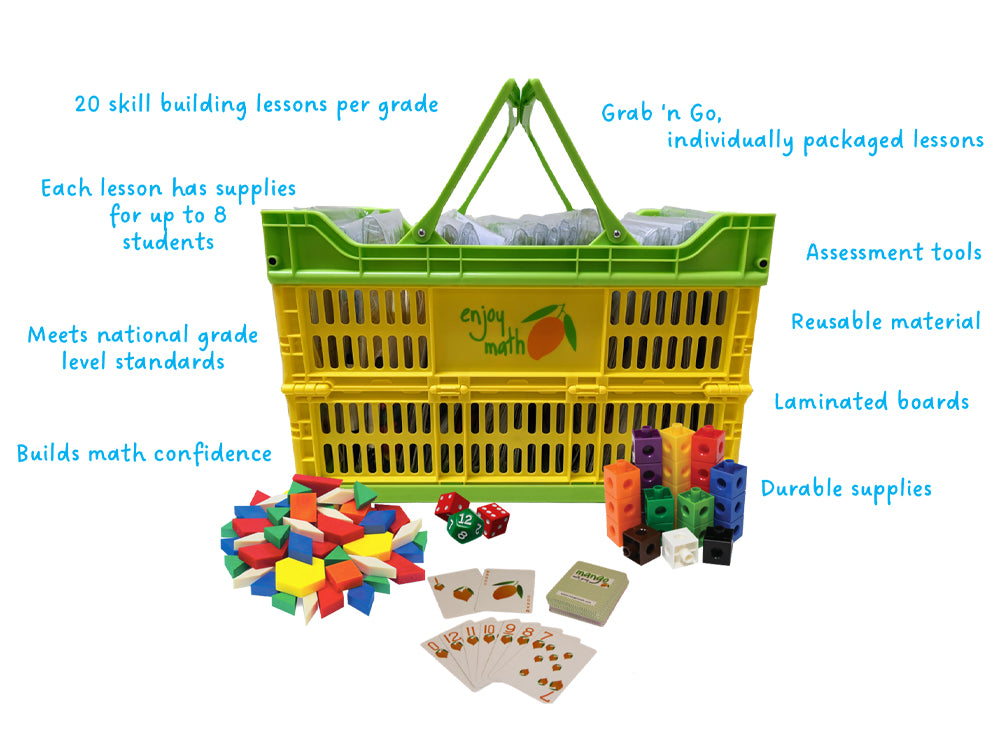
MANGO Math Deluxe Kits
Pricing Options:
- Ultimate Package (Grades K-8): 3,795.00 USD
- Transitional Kindergarten: 549.00 USD
- Kindergarten: 549.00 USD
- 1st Grade: 549.00 USD
- 2nd Grade: 549.00 USD
- 3rd Grade: 549.00 USD
- 4th Grade: 549.00 USD
- 5th Grade: 549.00 USD
- 6-8th Grade: 549.00 USD
Recommended Settings:
- Summer Camps
- Classrooms
- Out-of-School Time Programs
Tech Requirements:
- None
Curriculum Topics:
- Make sense of problems and persevere in solving them
- Reason abstractly and quantitatively
- Construct viable arguments and critique the reasoning of others
- Model with mathematics
- Use appropriate tools strategically
- Attend to precision
- Look for and make use of structure
- Look for and express regularity in repeated reasoning
Supporting Videos:
- Lesson videos are available for this program.
Each Kit Includes:
20 lessons that are tailored to their grade level, along with all of the supplies needed for up to 8 students at a time to complete each lesson.
Transitional Kindergarten:
- 1 Plastic carrying basket
- 1 Plastic Folder with game boards
- 10 Dry erase markers in plastic case
- 1 Curriculum Guide
- 2 Large Foam Dice
- 96 Bear Counters
- 100 Clothespins
- 1 Flash Cards 0-25
- 4 Number Path to 20
- 2 MANGO Math Playing Cards
- 400 Chain links
- 100 Snap Blocks
- 4 Ten Frame and five frame
- 2 Dice: Shapes
Kindergarten:
- 1 Plastic carrying basket
- 20 Lessons in individual plastic folders
- 24 Dry erase markers in plastic case
- 1 Curriculum Guide & Assessment Book
- 48 Bear counters
- 50 Clothespins
- 150 Two color counters
- 4 6-sided dice
- 2 Shape pattern block dice
- 4 Dice with numbers
- 8 Pawns
- 2 Pattern Blocks
- 8 Number Line - 0 - 30
- 2 Dominoes, double 9
- 4 MANGO Math Playing Cards
- 200 four-colored chain links
- 50 Small Button
- 300 Snap Blocks
- 2 Spinners,0-9
- 2 Transparent spinners
1st Grade:
- 1 Plastic carrying basket
- 20 Lessons in individual plastic folders
- 24 Dry erase markers in plastic case
- 1 Curriculum Guide & Assessment Book
- 200 plastic two color counters
- 8 Transparent counters
- 10 Dice: 1s 0-9 white
- 4 Dice: 10s 00-90
- 2 Dice: 12-sided
- 4 Dice: regular 6-sided dice
- 2 Dice: 20-sided
- 2 Dice: + -
- 2 Dice: color Single Spot
- 8 Dice: numbers
- 1 Flash Cards Number 1 to 100
- 4 Number Line - 0 - 30
- 4 Pattern Blocks (set of 49)
- 24 Pawns
- 2 Playing Cards
- 100 Chain links
- 2 Spinners, 0-9
- 100 Snap Blocks
- 2 Student Clocks
- 2 Bags Tangrams
2nd Grade:
- 1 Plastic carrying basket
- 20 Lessons in individual plastic folders
- 24 Dry erase marker in plastic case
- 1 Curriculum Guide & Assessment Book
- 150 Two color counters
- 2 Mixed Coin Set
- 100 Coins: pennies
- 100 Coins: Dimes
- 80 Color Tiles
- 18 6-sided dice
- 8 Dice: 1s 0-9
- 2 Dice: 10s 00-90
- 2 Dice: 30-sided
- 2 Fraction Tiles
- 2 Number Line - 0 - 30
- 100 Paper Money $1
- 100 Paper Money $10
- 50 Paper Money $100
- 40 Pawns
- 6 Playing Cards
- 100 Snap Blocks
- 2 Spinners, 0-9
- 2 Spinners, 6 colors
- 2 Spinners (transparent)
- 2 Student Clocks
3rd Grade:
- 1 Plastic carrying basket
- 20 Lessons in individual plastic folders
- 24 Dryerase marker in plastic case
- 1 Curriculum Guide & Assessment Book
- 150 Two color counters
- 2 Mixed Coin Set
- 240 Color Tiles
- 200 Two Color Counters
- 6 Dice: 1s 0-9
- 24 Dice: regular 6-sided dice
- 2 Dice: 20-sided
- 2 Dice: animal species
- 16 Pawns
- 2 Fraction Pattern Blocks
- 6 Playing Cards
- 4 Ruler
- 100 Snap Blocks
- 1 Spinners, 0-9
4th Grade:
- 1 Plastic carrying basket
- 20 Lessons in individual plastic folders
- 24 Dry erase markers in plastic case
- 1 Curriculum Guide & Assessment Book
- 80 Color Tiles
- 300 Two Color Counters
- 2 Dice: 1s 0-9
- 2 Dice: 10s 00-90
- 2 Dice: 100s 000-900
- 2 Dice: 12-sided place value words
- 16 Dice: 6-sided dice
- 2 Dice: fraction 1/12, 1/4, 1/3, 1/5, 1/6, 1/2
- 4 Dice: fraction 1/2, 2/3, 3/4, 5/6, 7/8, 11/12
- 1 Exploragon legs
- 2 Fraction tiles
- 1 Paper bags
- 2 Mixed Bill Set
- 6 Playing Cards
- 40 Pawns
- 6 Spinners (transparent)
- 2 Bags Tangrams
5th Grade:
- 1 Plastic carrying basket
- 20 Lessons in individual plastic folders
- 24 Dry erase marker in plastic case
- 1 Curriculum Guide & Assessment Book
- 2 Calculator
- 150 Two-Color Counters
- 4 Dice: 1, 2, 3
- 10 Dice: 1s 0-9
- 2 Dice: 10s 00-90
- 2 Dice: 100s 000-900
- 4 Dice: 12-sided
- 4 Dice: 6-sided dice
- 2 Dice: 20-sided
- 2 Dice: 25-30 dice
- 6 Dice: numbers
- 4 Dice: +/ -
- 2 Dice: fraction 1/12, 1/4, 1/3, 1/5, 1/6, 1/2
- 2 Dice: fraction 1/1, 1/2, 1/3, 1/4, 1/5, 1/6
- 1 Double 9 Dominoes
- 1 Bag Exploragons
- 2 Fraction Pattern Blocks
- 16 Pawns
- 1 Mixed Bill Set
- 3 Bags of centimeter cubes
- 8 Playing Cards
- 4 spinner (transparent)
6th-8th Grade:
- 1 Plastic carrying basket
- 20 Lesson in individual plastic folders
- 24 Dry erase markers in plastic case
- 1 Curriculum Guide & Assessment Book
- 2 Calculator
- 40 Color tiles
- 100 Two color counters
- 4 Dice: 1s 0-9
- 2 Dice: 7 - 12
- 4 Dice: 12-sided
- 14 Dice: 6-sided dice
- 4 Dice: 20-sided
- 2 Dice: 1000s 0000-9000
- 4 Dice: + -
- 2 Dice: operation dice + - x /
- 2 Dice: penguin
- 2 Dice:pigs
- 18 Exploragons
- 2 Pattern Block sets
- 2 Fraction Pattern Block sets
- 40 Pawns
- 4 Playing Cards
- 2 Spinners, 6 colors
- 4 Spinners (transparent)
Common Core State Standards for Mathematics:
Transitional Kindergarten
- CCTK.2 Count forward beginning from a given number.
- CCTK.3 Write numbers 0-20.
- CCTK.4 Cout to tell the number of objects. Understand the relationship between numbers and quantity.
- CCTK.5 Count to answer “how many.”
- CCTK.6 Compare numbers.
- OATK.1 Represent addition and subtraction with objects.
- OATK.3 Decompose numbers into pairs in more than one way.
- MDTK.3 Classify objects into given categories.
- GTK.1.a Describe objects in the environment using names of shapes.
- GTK.1.b Describe the relative positions of these objects using terms such as above, below, beside, in front, next to.
- GTK.2 Correctly name shapes.
Kindergarten:
- K.CC.A Know number names and the count sequence.
- K.CC.B Count to tell the number of objects.
- K.CC.C Compare numbers.
- K.OA.A Understand addition as putting together and adding to, and understand subtraction as taking apart and taking from.
- KNBT.A Work with numbers 11-19 to gain foundations for place value.
- K.MD.A Describe and compare measurable attributes.
- K.MD.B Classify objects and count the number of objects in categories.
- K.G.A Identify and describe shapes.
- K.G.B Analyze, compare, create, and compose shapes.
1st Grade:
- 1.OA.A Represent and solve problems involving addition and subtraction.
- 1.OA.B Understand and apply properties of operations and the relationship between addition and subtraction.
- 1.OA.C Add and subtract within 20.
- 1.OA.D Work with addition and subtraction equations.
- 1.NBT.A Extending the counting sequence.
- 1.NBT.B Understand place value.
- 1.NBT.C Use place value understanding and properties of operations to add and subtract.
- 1.MD.A Measure lengths indirectly and by iterating length units.
- 1.MD.B Tell and write time.
- 1.MD. C Represent and interpret data.
- 1.G.A Reason with shapes and their attributes.
2nd Grade:
- 2.OA.A Represent and solve problems involving addition and subtraction.
- 2.OA.B Add and subtract within 20.
- 2.OA.C Work with equal groups of objects to gain foundations for multiplication.
- 2.NBT.A Understand place value.
- 2.NBT.B Use place value understanding and properties of operations to add and subtract.
- 2.MD.A Measure and estimate lengths in standard units.
- 2.MD.B Relate addition and subtraction to length.
- 2.MD.C Work with time and money.
- 2.MD.D Represent and interpret data.
- 2.G.A Reason with shapes and their attributes.
3rd Grade:
- 3.OA.A Represent and solve problems involving multiplication and division.
- 3.OA.B Understand properties of multiplication and the relationship between multiplication and division.
- 3.OA.C Multiply and divide within 100.
- 3.OA.D Solve problems involving the four operations and identify and explain patterns in arithmetic.
- 3.NBT.A Use place value understanding and properties of operations to perform multi-digit arithmetic.
- 3.NF.A Develop understanding of fractions as numbers.
- 3.MD.A Solve problems involving measurement and estimation of intervals of time, liquid volumes, and masses of objects.
- 3.MD.B Represent and interpret data.
- 3.MD.C Geometric measurement: understand concepts of area and relate area to multiplication and to addition.
- 3.MD.D Geometric measurement: recognize perimeter as an attribute of plane figures and distinguish between linear and area measures.
- 3.G.A Reason with shapes and their attributes.
4th Grade:
- 4.OA.A Use the four operations with whole numbers to solve problems.
- 4.OA.B Gain familiarity with factors and multiples.
- 4.OA.C Generate and analyze patterns.
- 4.NBT.A Generalize place value understanding for multi-digit whole numbers.
- 4.NBT.B Use place value understanding and properties of operations to perform multi-digit arithmetic.
- 4.NF.A Extend understanding of fraction equivalence and ordering.
- 4.NF.B Build fractions from unit fractions by applying and extending previous understandings of operations on whole numbers.
- 4.NF.C Understand decimal notation for fractions, and compare decimal fractions.
- 4.MD.A Solve problems involving measurement and conversion of measurements from a larger unit to a smaller unit.
- 4.MD.B Represent and interpret data.
- 4.MD.C Geometric measurement: understand concepts of angle and measure angles.
- 4.G.A Draw and identify lines and angles, and classify shapes by properties of their lines and angles.
5th Grade:
- 5.OA.A Write and interpret numerical expressions.
- 5.OA.B Analyze patterns and relationships.
- 5.NBT.A Understand the place value system.
- 5.NBT.B Perform operations with multi-digit whole numbers and with decimals to hundredths.
- 5.NF.A Use equivalent fractions as a strategy to add and subtract fractions.
- 5.NF.B Apply and extend previous understandings of multiplication and division to multiply and divide fractions.
- 5.MD.A Convert like measurement units within a given measurement system.
- 5.MD.B Represent and interpret data.
- 5.MD.C Geometric measurement: understand concepts of volume and relate volume to multiplication and to addition.
- 5.G.A Graph points on the coordinate plane to solve real-world and mathematical problems.
- 5.G.B Classify two-dimensional figures into categories based on their properties.
6-8th Grade:
- 6.NS.A Apply and extend previous understandings of multiplication and division to divide fractions by fractions.
- 6.NS.B Compute fluently with multi-digit numbers and find common factors and multiples.
- 6.NS.C Apply and extend previous understandings of numbers to the system of rational numbers.
- 6.EE.A Apply and extend previous understandings of arithmetic to algebraic expressions.
- 6.EE.B Reason about and solve one-variable equations and inequalities.
- 6.G.A Represent and analyze quantitative relationships between dependent and independent variables.
- 6.SP.A Solve real-world and mathematical problems involving area, surface area, and volume.
- 7.RP.A Analyze proportional relationships and use them to solve real-world and mathematical problems.
- 7.NS.A Apply and extend previous understandings of operations with
fractions to add, subtract, multiply, and divide rational numbers. - 7.EE.B Solve real-life and mathematical problems using numerical and algebraic expressions and equations.
- 7.G.A Draw, construct and describe geometrical figures and describe the relationships between them.
- 7.G.B Solve real-life and mathematical problems involving angle measure, area, surface area, and volume.
- 8.EE.C Analyze and solve linear equations and pairs of simultaneous linear equations.
- 8.G.C Solve real-world and mathematical problems involving volume of cylinders, cones and spheres.
© Copyright 2010. National Governors Association Center for Best Practices and Council of Chief State School Officers. All rights reserved.
MANGO Math
The name MANGO is an acronym of the different math strands: measurement, algebra, number sense, geometry and data/probability (which we changed to odds/order to create the O in MANGO). We help educators teach these MANGO concepts with engaging, activity-based lessons. We love that the name brings a colorful, positive attitude towards math that is often missing.
Math is the single strongest indicator for future academic and financial success. MANGO Math helps to create that strong foundation.







